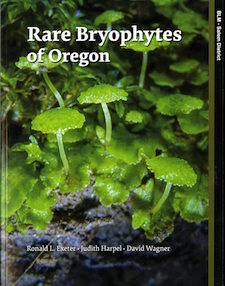Rare Bryophytes of Oregon
Last Updated on November 21, 2022 by

by Ronald L. Exeter, Judith Harpel and David Wagner
ISBN 13: 978-0-9791310-4-2
Salem District, Bureau of Land Management. Salem, Oregon, 2016
Largely due to the Northwest Forest Plan and other government programs, federal land management agencies in Oregon are mandated to survey and mitigate for many taxa, including bryophytes (mosses, liverworts, and hornworts). The list of species that the agencies survey is maintained by the Oregon Biodiversity Information Center (ORBIC, formerly the Oregon Natural Heritage Program). Existing references on bryophytes had become outdated, and the intensive surveys created a need for identification resources, especially for rare taxa. Rare Bryophytes of Oregon is a new identification guide for all species found on the 2013 ORBIC list and those proposed for addition to the 2016 ORBIC revision.
For decades, each of the authors has played an integral role in rare bryophyte conservation and public land management in Oregon. Ron Exeter is the Botanist for Mary’s Peak Resource Area of the Salem District BLM; Judith Harpel and Dave Wagner, each with extensive backgrounds in bryology, have worked as consultants for the federal government for many years. My interest in reviewing this book comes from having worked for 22 years as a consultant doing inventories of these listed bryophytes for federal agencies.
The introductory section contains the following sections: the history of rare plant protection in Oregon, publications and references, life history strategies and ecological roles, threats to bryophyte sites, conservation considerations, data gaps, distribution (using tables that show which taxa occur in each ecoregion) and classification (how the treated taxa are grouped in Division, Class, Order and Family). The bulk of the book (pages 21 through 341) is devoted to descriptions of 142 taxa (102 mosses, one hornwort, and 39 liverworts). Each species account includes the following: the Latin name and authority, recent synonyms, common names (though few are widely used), a short summary, a list of diagnostic characteristics, technical descriptions of both gametophyte and sporophyte, comparisons with similar species, sections on ecology and distribution, and references. The technical descriptions are compiled from a variety of sources, some of which are not readily available. The sections that describe diagnostic characteristics and similar species contain key criteria for species identification; the authors tell clearly how to identify the rare species and distinguish them from lookalikes. Those sections, along with ecology and distribution sections, often contain information that is derived from professional experience or is not obvious in published literature. These sections showcase the authors’ expertise and I can think of very little to add of any importance. Overall, these comprehensive species accounts are superbly researched.
Each species treatment includes a page of excellent photographs, up to fourteen per species, approximately 1350 total, nearly all of which are in color. Most of the images are micrographs. Line drawings are occasionally included. The photos, especially the micrographs, wonderfully represent the diagnostic characteristics. They were taken of mounts created from specimens originating from a wide variety of collections. It is obvious that creating these photos took a great deal of effort. As such, they are the most valuable component of the book. The scale bar numbers and photo credits found on the photos are not in a standard font size. I assume this is due to these features being embedded in the images prior to resizing of the photos for publication. Unfortunately, in some of the photos the font is so small that it is difficult to read. In addition, the plates include relatively few in situ photos. Although impractical for many of the included species, more photos of the plants in the wild could have given the user a better sense of the natural habitats as well as improved search images for the field surveys.
The book closes with distribution maps for each taxon, a list of abbreviations and acronyms, a cross-reference list of vascular plant scientific and common names referred to in the text, and literature cited. In the distribution maps, entire counties are shaded to represent the presence of a given species. Since Oregon counties often include multiple mountain ranges and ecoregions, users may prefer dot-maps for a more accurate representation of the numbers and concentrations of populations and their placement in Oregon ecoregions.
There are no identification keys, for good reason. A key limited to just rare species would be impractical, while a key that includes all bryophytes known or suspected to exist in Oregon is far beyond the scope of the book.
Rare Bryophytes of Oregon is aimed at the professional biologist or at least the seriously advanced amateur. Although a bit large to be considered a field guide (8.5 × 11 inches, almost an inch thick), the digital copies on the accompanying CD can be loaded on mobile devices for field use. With microscopy generally being an integral part of bryophyte identification, many users may find the book to have greater application in the lab instead of the field.
The authors should be commended on producing a well written, visually attractive, and informative book. Rare Bryophytes of Oregon will be indispensable to government agency botanists and land managers in Oregon for years to come. It will also be a very useful tool to those concerned with bryophyte conservation outside of Oregon, as many of the treated species are either of conservation concern in other jurisdictions or have the potential to be listed there. Many of the treated species are not found in other guidebooks or are poorly represented. Everyone with more than a passing interest in bryophytes of Oregon or the Pacific States should consider acquiring this book. The price is a great value, especially considering that it includes the CD and the cost of shipping.
—Scot Loring, Siskiyou Chapter.
[Ed. Note: Scot modestly neglected to mention that his credentials include coauthor on the companion book to this bryophyte volume, Rare Lichens of Oregon.]
